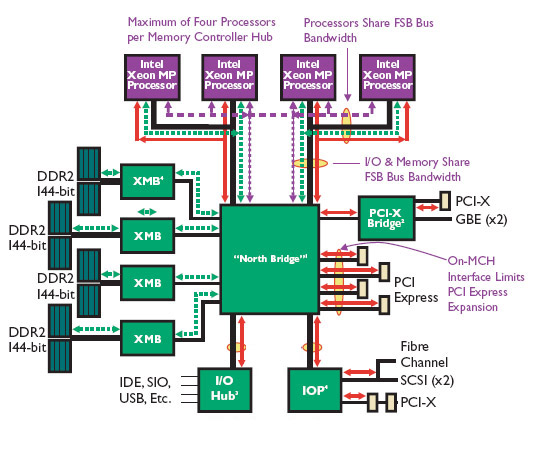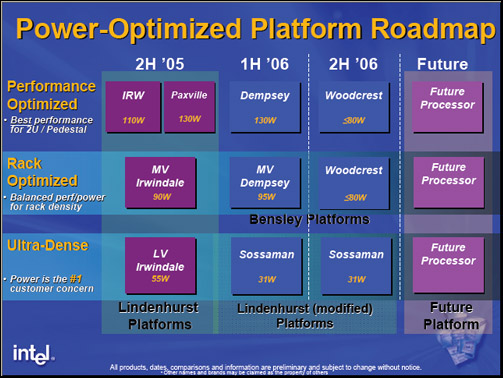Eight Core Servers: Opteron 880 (Egypt) vs. Xeon MP 3.0 GHz (Paxville)
by Jason Clark on April 24, 2006 2:00 AM EST- Posted in
- IT Computing
What do we have today?
The current AMD platform hasn't changed much at all; the only change has really been the move to 1GHz HyperTransport. The K8 architecture is fairly old news now, but is certainly still more scalable and higher performing than Intel's offerings. Intel hasn't made any significant changes, though the E8500 chipset does use a dual shared bus instead of a single bus from the older Xeon MP chipsets. The shared bus helps the bandwidth bottleneck, but with more than 4 processor cores scalability really starts to slow. The diagrams below give a high level overview of the 4P architecture that AMD and Intel currently offer.
Current 4P Architecture


AMD Server Processor Roadmap
As we mentioned, there haven't been any changes to Opteron recently, besides a speed bump and a move to 1GHz HyperTransport last year. Although the Opteron is getting up there in years, it's still a proven, scalable architecture. AMD does have some changes on the horizon for Opteron, though: DDR2 and a new socket. Will that be enough to keep them on top when Woodcrest is released? Only time will tell, but if our recent preview of socket AM2 performance is any indication, changing the server platforms to DDR2 isn't likely to increase performance much over current offerings.
We haven't seen any indications of pending changes other than the socket and memory controller. AMD is being very tightlipped about their plans for Opteron, but below is a synopsis of what we know is on the books.
Highlights
Intel Server Processor Roadmap
Intel has actually been quite forthcoming about what they are working on, for obvious reasons. They need the market to know that they are going to be competitive, and how that will be accomplished. The first two quarters of 2006 will introduce the Bensley platform, which brings the Dempsey Dual Core Xeons.
The last two quarters of the year are where things get interesting. Woodcrest is to debut in the second half of this year. Woodcrest is supposed to drop power consumption from 130W (Dempsey) to <80W, which should make a huge impact on the power consumption numbers we measured earlier this year for Dempsey. Note that Woodcrest processors will also run on the Bensley platform.

The current AMD platform hasn't changed much at all; the only change has really been the move to 1GHz HyperTransport. The K8 architecture is fairly old news now, but is certainly still more scalable and higher performing than Intel's offerings. Intel hasn't made any significant changes, though the E8500 chipset does use a dual shared bus instead of a single bus from the older Xeon MP chipsets. The shared bus helps the bandwidth bottleneck, but with more than 4 processor cores scalability really starts to slow. The diagrams below give a high level overview of the 4P architecture that AMD and Intel currently offer.
Current 4P Architecture


AMD Server Processor Roadmap
As we mentioned, there haven't been any changes to Opteron recently, besides a speed bump and a move to 1GHz HyperTransport last year. Although the Opteron is getting up there in years, it's still a proven, scalable architecture. AMD does have some changes on the horizon for Opteron, though: DDR2 and a new socket. Will that be enough to keep them on top when Woodcrest is released? Only time will tell, but if our recent preview of socket AM2 performance is any indication, changing the server platforms to DDR2 isn't likely to increase performance much over current offerings.
We haven't seen any indications of pending changes other than the socket and memory controller. AMD is being very tightlipped about their plans for Opteron, but below is a synopsis of what we know is on the books.
Highlights
- DDR2 (2006)
- AM2 Socket (2006
- Multi Core (2007)
- FBDIMM (2007)
- Shared L3 Cache (2007)
Intel Server Processor Roadmap
Intel has actually been quite forthcoming about what they are working on, for obvious reasons. They need the market to know that they are going to be competitive, and how that will be accomplished. The first two quarters of 2006 will introduce the Bensley platform, which brings the Dempsey Dual Core Xeons.
The last two quarters of the year are where things get interesting. Woodcrest is to debut in the second half of this year. Woodcrest is supposed to drop power consumption from 130W (Dempsey) to <80W, which should make a huge impact on the power consumption numbers we measured earlier this year for Dempsey. Note that Woodcrest processors will also run on the Bensley platform.











35 Comments
View All Comments
coldpower27 - Monday, April 24, 2006 - link
At least then by the time you do replace your machines hopefully Intel will be more competitive in this spaceAnemone - Monday, April 24, 2006 - link
Honestly it doesn't hurt to bring the point home again and again about Opteron. Those making buying decisions who are still stuck on Intel only solutions need the truth laid out for them regularly and repeatedly, imo. Thank you for doing that, because the current Intel solutions are a waste of money, and I hate that the most of all.:)
johnzo - Monday, April 24, 2006 - link
Are your test result comments correct? ie DVD Store Test, should the AMD lead be 40% not 29% ?AMD has 8853 more orders, which is 40% more than 21782.The same error (?) goes for the other percentages mentioned.
If I am wrong please forgive somebody with an old brain !
Jason Clark - Monday, April 24, 2006 - link
You are correct, my mistake. This is fixed.psychobriggsy - Monday, April 24, 2006 - link
Right, using funky-maths, if a 2.6GHz Conroe is 20% faster than a 2.8GHz X2.And this 8-core 2.6GHz (?) Opteron system is 40% faster than a 3GHz 8-core Xeon.
And the issue is scalability, i.e., the same problem will exist for Woodcrest.
However Woodcrest will be 3GHz, but this will only be useful for cache-bound tasks because of the scalability problems (expect all the Intel biased websites to only benchmark Woodcrest with this type of task). Maybe Opteron will be dual-core 3GHz by then...
Anyway I can't conclude anything without making huge vast leaps of guesswork, but yes, it will be very close later this year, but if Woodcrest can't beat Opteron because of the platform limitations then there will be little to no incentive to switch back from buying Opteron based servers to Intel based servers (for the companies that have switched to AMD), apart from power consumption.
However it means Intel will stop losing customers to AMD in the server space, if the performance and power consumption issues are addressed. By no means do I see AMD losing much of their gained marketshare however (and by Q4 it will be higher than now I'm sure).
peternelson - Monday, April 24, 2006 - link
If power consumption is your concern, then AMD offer reduced power versions of Opteron chips (eg the HE models) at increased cost. When they can migrate to 65nm process, we should see even better power economy.
Furen - Monday, April 24, 2006 - link
Here's what I think will happen. AMD will get a run for its money on the single-socket and dual-socket arenas (since dual-FSB pretty much keeps the FSB from being too limiting) but once you scale higher AMD will once again rule the roost. I also think that quad-core will be better on AMD's architecture, too, since throwing 4 Conroe/Woodcrest cores on a single FSB (266MHz I'd expect, though I suppose it could be 333) will give these cores a huge performance hit, more so in MP configurations (just thinking about the cache-coherency traffic for 8 cores scares me)coldpower27 - Monday, April 24, 2006 - link
Maybe, but it's hard to say at this point, how low FSB speed will affect Core Architecture, plus this is the Xeon MP space, where it won't be transistioning to Core Architecture for sometime until Q1 2007 earliest from what I believe with the Clovertown MP/Tigerton Core, I don't think there is a Woodcrest equivalent for this space.I expect AMD to have the "FSB" advantage in 4-8 way situations yes, however this may or may not translate to a performance crown for AMD.
Thoug I think it's pretty safe for Intel that they can take back the Xeon DP space with Woodcrest, and DIB.
JarredWalton - Monday, April 24, 2006 - link
I think you need to remember a couple of things. First, Woodcrest is based off of the next-generation Core architecture. Power and performance characteristics will be completely different from the current NetBurst chips. Second, Woodcrest will also have a 1333 MHz front side bus -- twice as fast as the server benchmarked here. Finally, and I could be wrong on this, but I think Intel is looking at one shared front side bus for every two sockets, and they could potentially move to one front side bus for each socket.That last idea would make sense for quad-core. And speaking of quad core, that's such a significant change that again it's almost impossible to predict at this stage. I mean, we don't even really know how AMD or Intel are going to build their quad core packages. Are we talking a single die, or will they have multiple dice on a package? Will Intel change the way the dice communicate with each other?
Of course, none of this things means that Intel will come out on top, but there are enough significant changes that we can't declare a victor at this point. Also, large L3 caches can indeed help server work. Otherwise, why would IBM even make a POWER5 chip with 128 MB of L3 cache? Adding tons of cache to a desktop system rarely helps, but enterprise servers are completely different beast.
At the very least, things should get interesting later this year. :-)
Furen - Monday, April 24, 2006 - link
You are indeed correct.In the DVD store test the AMD system is indeed 40% faster than the Intel system, but the Intel system is 30% slower than the AMD one. He seems to have chosen the AMD scores as the reference but incorrectly says that AMD is 30% faster instead of saying that Intel is 30% slower.